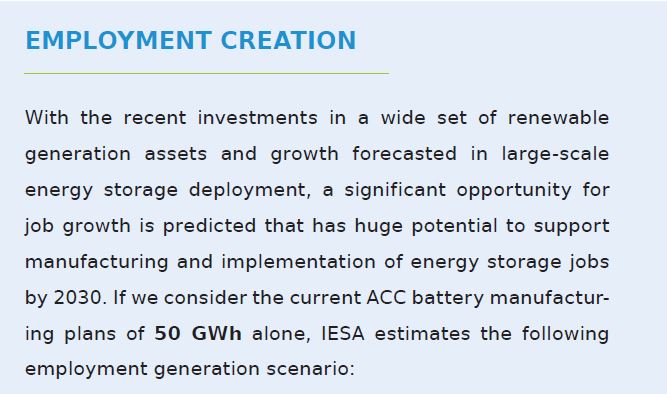IESA Energy Storage Vision 2030 report which emphasizes the importance of energy storage target-setting for India along with other key areas like policy and regulatory intervention required at the Central and the State level, manufacturing, skill development, research & development, and potential barriers that require preparedness and focus from the Centre and the States.
IESA has been conducting meticulous research in the field of energy storage and policy analysis for the past decade and has been a member of various committees including, large-scale renewable integration taskforce (2013- 15), the standing committee on energy storage to develop National Energy Storage Roadmap (2014-16), Expert Committee to draft National Energy Storage Mission (2017-18), Central Advisory Committee of CERC, drafting committee on “Comprehensive Energy Storage Policy” among others. 
Report launch at India Energy Storage Week (IESW) 2022.
From L- to R:- Stephen Fernands, President, Customized Energy Solutions; Achal Sondhi, VP - Growth, APAC, Fluence; Yashwanth Mahadevan, Sales Leader, Eos Energy; Debi Prasad Dash, Executive Director, IESA; Shri. Ghanshyam Prasad, Joint Secretary, Ministry of Power, Govt. of India; Shri Dinesh Jagdale, Joint Secretary, Ministry of New and Renewable Energy, Govt. of India; Bindu Madhavi, Director, Regulatory & Policy, IESA and Dr Rahul Walawalkar, President, IESA, MD, CES (India)

Highlights from the Report
- The vision document has highlighted the requirement for setting up of storage targets in India with a clear focus on application sector, and policy and regulatory interventions required at the Center and the State level.
- Along with it, this document has also identified potential barriers towards active ESS adoption in India, the framework required based on target projections and incentives, and the support required from the Central and the State governments. For accuracy in providing the data, prediction and analysis, IESA had organized series of round table discussions with Central and State Governments, regulators, think tanks etc
- Key Objective of the study is to highlight the following
- Vision towards storage to achieve the country’s RE targets by 2030 and setting a target/goal/mandate for energy storage for year 2030
- Incentives and support from government authorities
- Focus on a pipeline of projects for the next few years. In many cases, actual storage deployment was even higher than the earlier set targets
- This study indicates a projected storage capacity requirement of 160 GWh, considering energy storage system (ESS) application of grid-scale storage (also referred to as front-of-the-meter) applications, renewable energy integration, distribution utility installation, ancillary services, and transmission investment deferral (Green Energy Corridor only). However, this projection does not include transmission planning, inverter, UPS, telecom, residential behind-the-meter applications
- To seize the huge opportunities offered by the energy storage sector, the immediate steps that are required toward the effective adoption of energy storage technologies are identified and highlighted
- It also covered the areas that need to be examined to support Indian RE targets as well as clean energy transition
- To achieve the targets, it is required to define calculations of storage purchase obligations in terms of percentage requirement for particular RE capacity.
- This report also reflects key pillar strategies bound to play a major role in shaping regulations and utilizing energy storage at full potential
- Merely considering the current ACC battery manufacturing plans of 50 GWh, IESA estimates that the program shall generate a minimum of 5 lakh employment opportunities, which includes 10,000-25,000 Merely considering the current ACC battery manufacturing plans of 50 GWh, IESA estimates that the program shall generate a minimum of 5 lakh employment opportunities, which includes 10,000-25,000











 Policy & Regulatory Advocacy
Policy & Regulatory Advocacy






